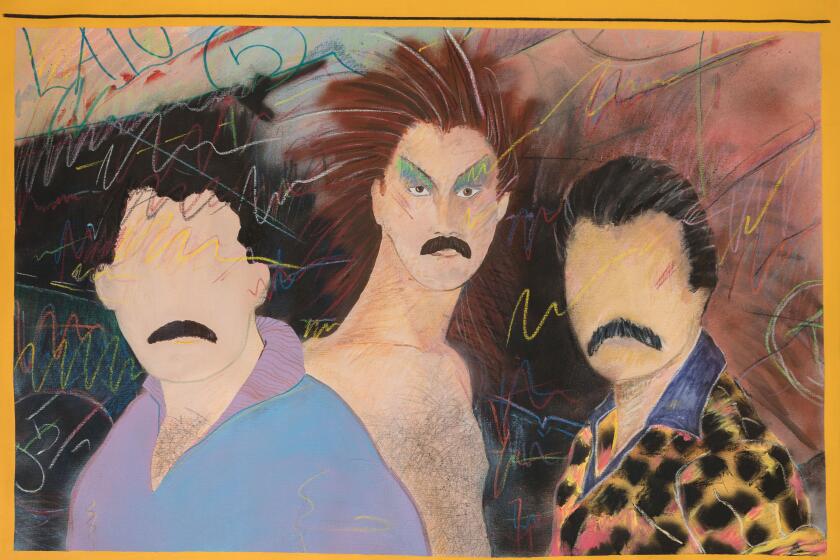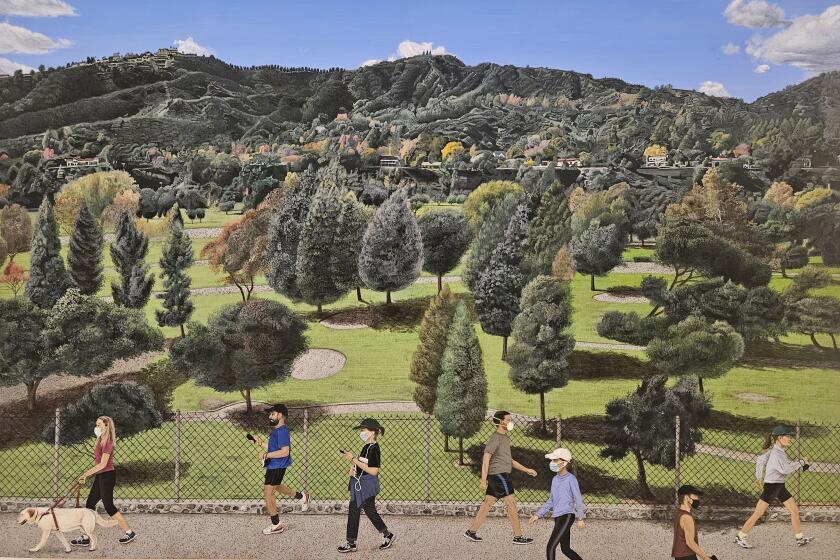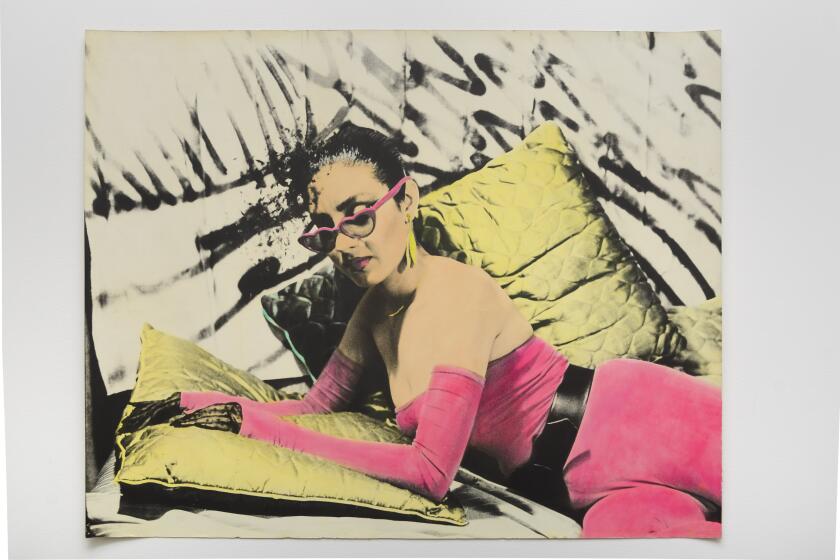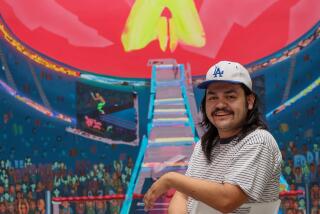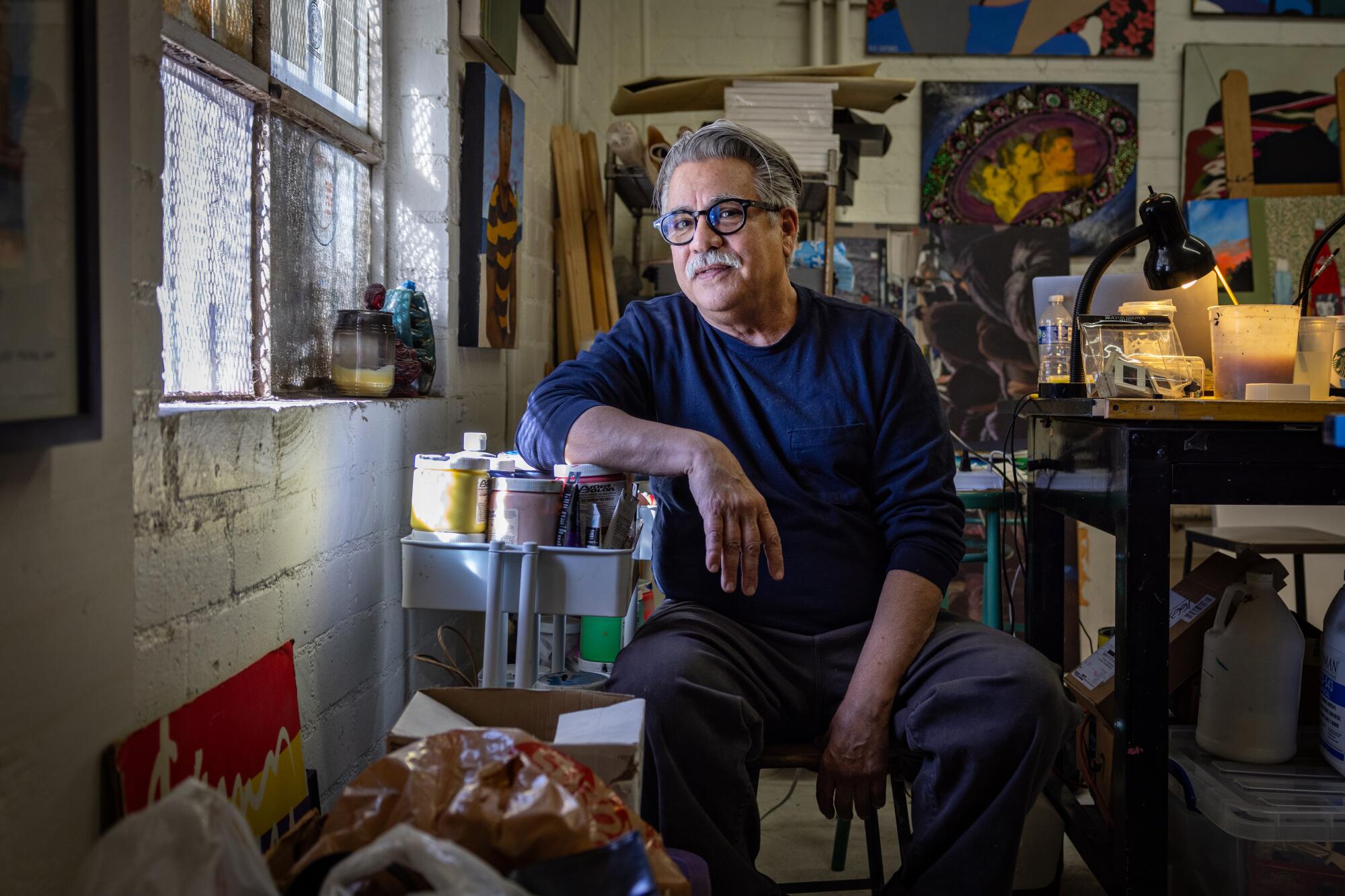
- Share via
It was 1997. Joey Terrill was feeling grateful to be alive, but also conflicted about it. The artist had spent the ’80s losing friends and lovers to the ravages of AIDS. In 1989, he had been diagnosed with HIV himself. For a time, he wore the diagnosis like a death sentence. But the development of more effective medications in the ’90s gave patients with the once fatal disease a new lease on life. In 1996, Terrill’s doctor informed him that his viral load was so low it was undetectable. “Undetectable,” he recalls, a quiver of emotion present in his voice. “It was such a moment of clarity.”
The moment, however, also presented a dilemma. How did he survive when so many others didn’t? And how could he make art about AIDS that was about simply being alive? “There’s been art about the politics of AIDS,” he says, seated amid the clutter of his Boyle Heights studio. “There’s been art against the government, art about grieving, the sadness, the anger. And I have this ambivalence about the fact that I am alive and the pharmaceutical industry is reaping billions. ... How could I portray this?”
Work by Teddy Sandoval at VPAM and a multigenerational exhibition at the Cheech dig into queerness, gender and the politics of the body.
The path forward presented itself at the kitchen table. “I was having breakfast and there is a box of Cheerios there and my [HIV] medications, and I thought, this is a Tom Wesselmann still life,” he explains, referring to the mixed-media paintings of the late Pop artist. “But I wanted to queer-ize and Mexican-ize this recipe.”
So Terrill set about painting still lifes: sensual arrangements of foodstuffs and flowers set against ebullient wallpapers and bright serapes (a nod to his Mexican heritage). Into these domestic settings, he introduces textured, often larger-than-life depictions of his HIV medications. Occasionally, an attractive male nude can be seen lingering in the background.
One of the earliest works in this vein, “Still-Life with Crixivan,” a mixed-media painting from 1997 to ’98, features a large cucumber cheekily evoking a generously proportioned phallus. To the surface of the canvas, the artist adhered Crixivan tablets from an old prescription. In the ’90s, he had taken the drug as part of a clinical trial, but was forced to quit after crippling side effects. “I had kidney stones and it was horrible,” he remembers. The pills ended up on his paintings instead.
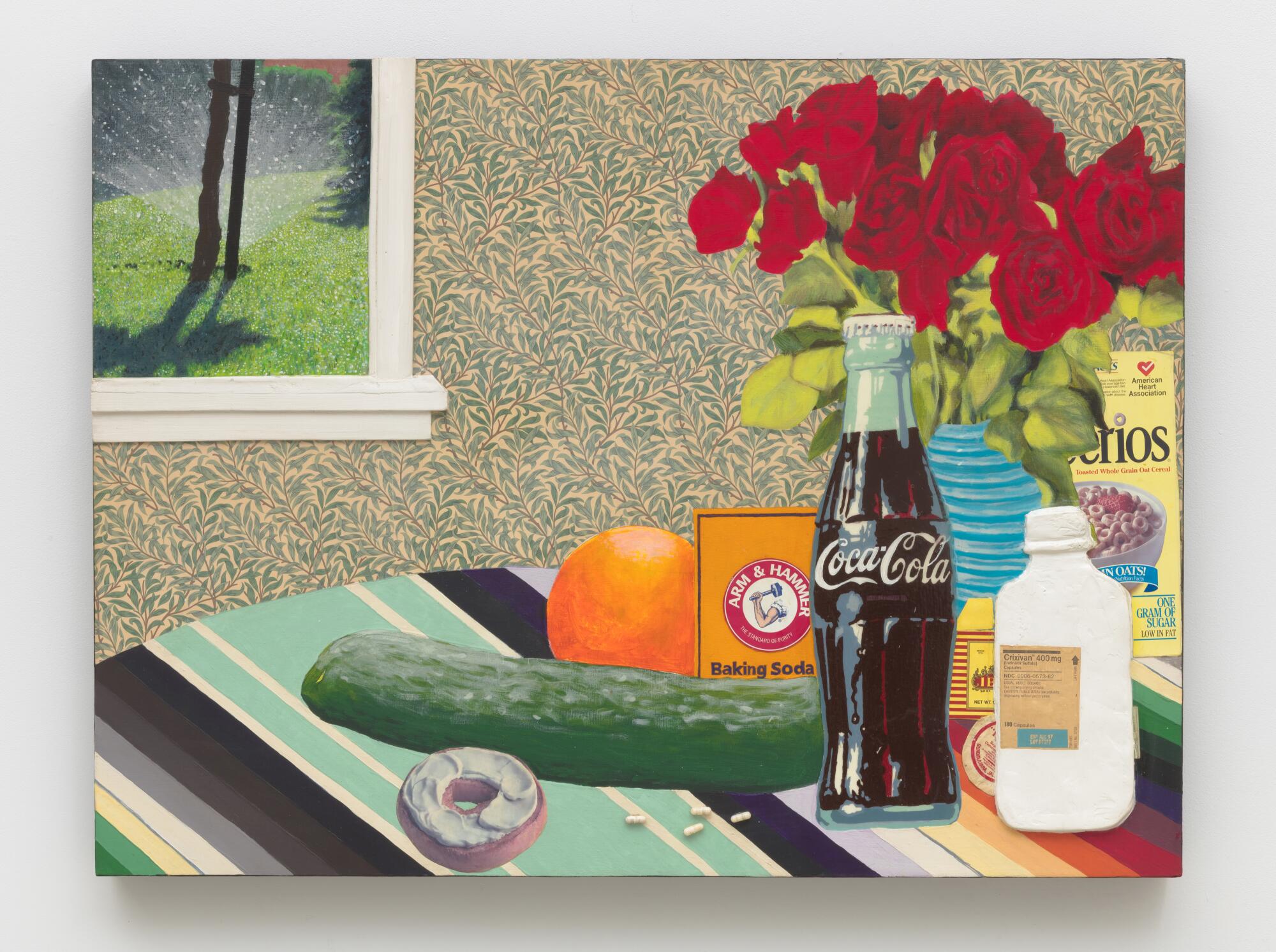
“Still-Life with Crixivan” is one of almost two dozen works by the artist — most of them still lifes — on view at Marc Selwyn Fine Art in Beverly Hills through early March. The exhibition marks a major solo outing for Terrill in Los Angeles, putting a spotlight on an artist and activist who, for decades, has chronicled his life and that of a circle of Chicano intimates in poignant and irreverent ways.
It also marks a moment in which Terrill, at the age of 68, is ascendant. In 2021, his still lifes were prominently featured in “Estamos Bien: La Trienal 20/21,” the artist survey organized by El Museo del Barrio in New York. This was followed by solo exhibitions at Paul Soto gallery in L.A. and Ortuzar Projects in New York. Late last year, he appeared in the sixth installment of the Hammer Museum’s “Made in L.A.” biennial in Westwood (drawing the notice of Times art critic Christopher Knight). Across town, the Museum of Contemporary Art in Los Angeles is currently displaying a large-scale collage by the artist titled “My First Crush,” 1993 — a piece it acquired in 2022.
His late renown is partly due to the fact that for many years, Terrill was more focused on HIV advocacy than on managing an art career, holding key positions at organizations such as the AIDS Healthcare Foundation and the Center for the Partially Sighted. (“AIDS is wartime,” he tells me. “I needed to put my focus in the advocacy and work the art in there when I could.”) Now, however, he is retired from that work and fully focused on art.
The warm institutional embrace he has received as of late — the Whitney Museum of American Art and the Museum of Modern Art in New York have also acquired paintings — can also be attributed to an art world that has finally caught up to a painter whose work eludes tidy categories.
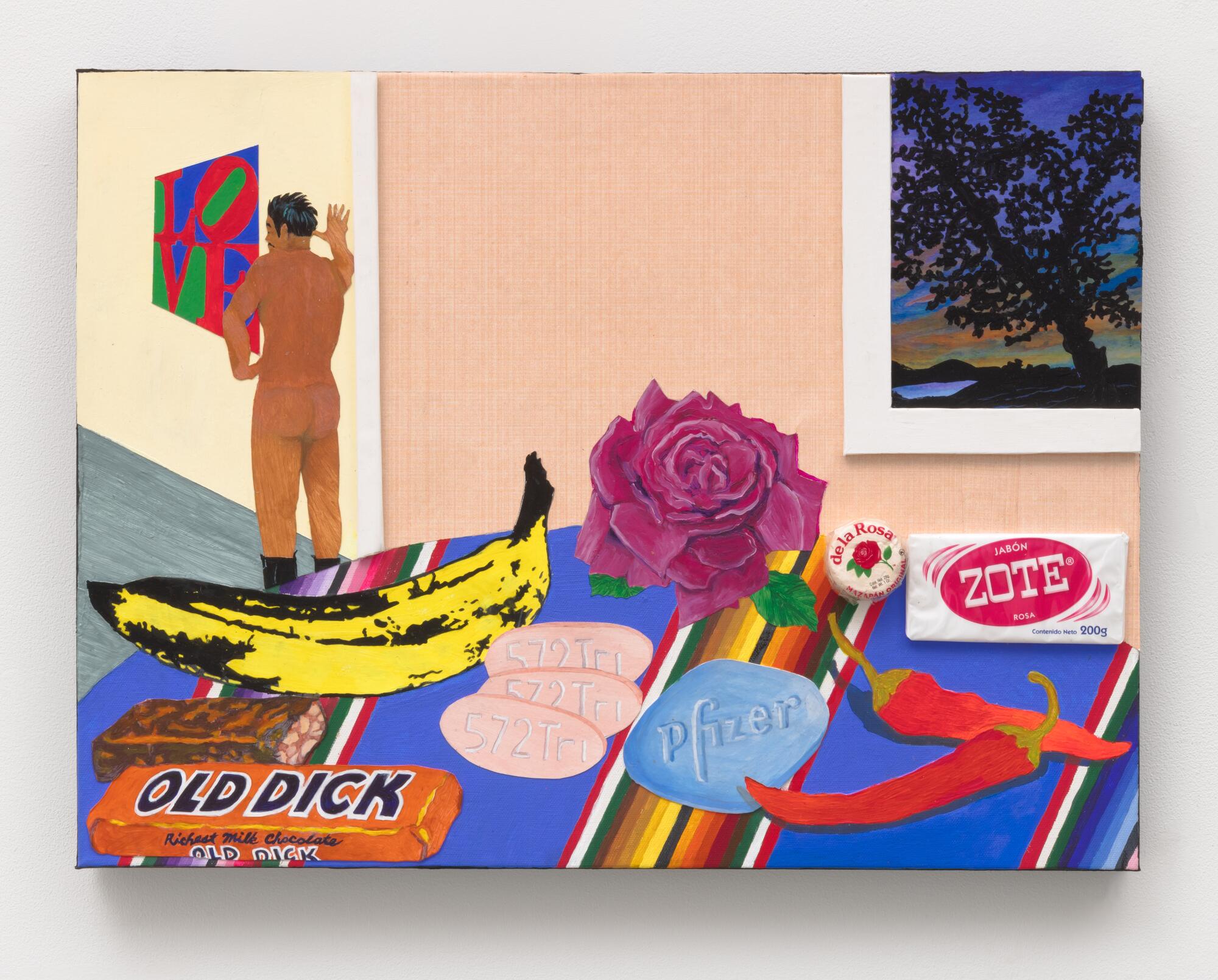
Terrill’s paintings explore Chicano themes but frequently avoid the common signifiers of Chicano art. His canvases are political, yet not overtly so. In the ’80s, for example, he created paintings that placed him and his friends within prominent cultural sites — including an Isamu Noguchi-designed landscape — a way of slyly inserting the Chicano presence into the culture. Others speak to the nuances of queer life, such as the 1984-85 series “Breaking Up / Breaking Down,” which functions as a diaristic depiction of the artist in the wake of a breakup: reading, taking drugs, yearning for the lover who has left. In one panel, the Hollywood sign is visible in the distance; others feature subtle references to Catholic religious imagery and Mexican iconography.
“In some circles of Chicano art, you probably saw more deliberate representation of identity politics and big political statements,” says Hammer curator Pablo José Ramírez. “But he had this more intimate dimension of the political in his work.”
The Hammer Museum’s sixth biennial survey, offering hugely diverse work made by the show’s 39 artists, is marked by the pandemic catastrophe and materiality.
Ramírez says he sees a powerful urgency in the work — one “manifested in keeping family and community connections alive.”
The artist says the show at Selwyn has been an opportunity to stop and take stock — in this case, of the still lifes he began to paint after he learned that his viral load was undetectable. “To see them all together, to see them in the gallery space,” he says, “I was like, ‘Wow, it’s an achievement.’”
Collectively, the paintings burst with heartache, humor, longing and the bittersweet feelings of being one who lives to tell the tale. The title of his exhibition: “Still Here.”
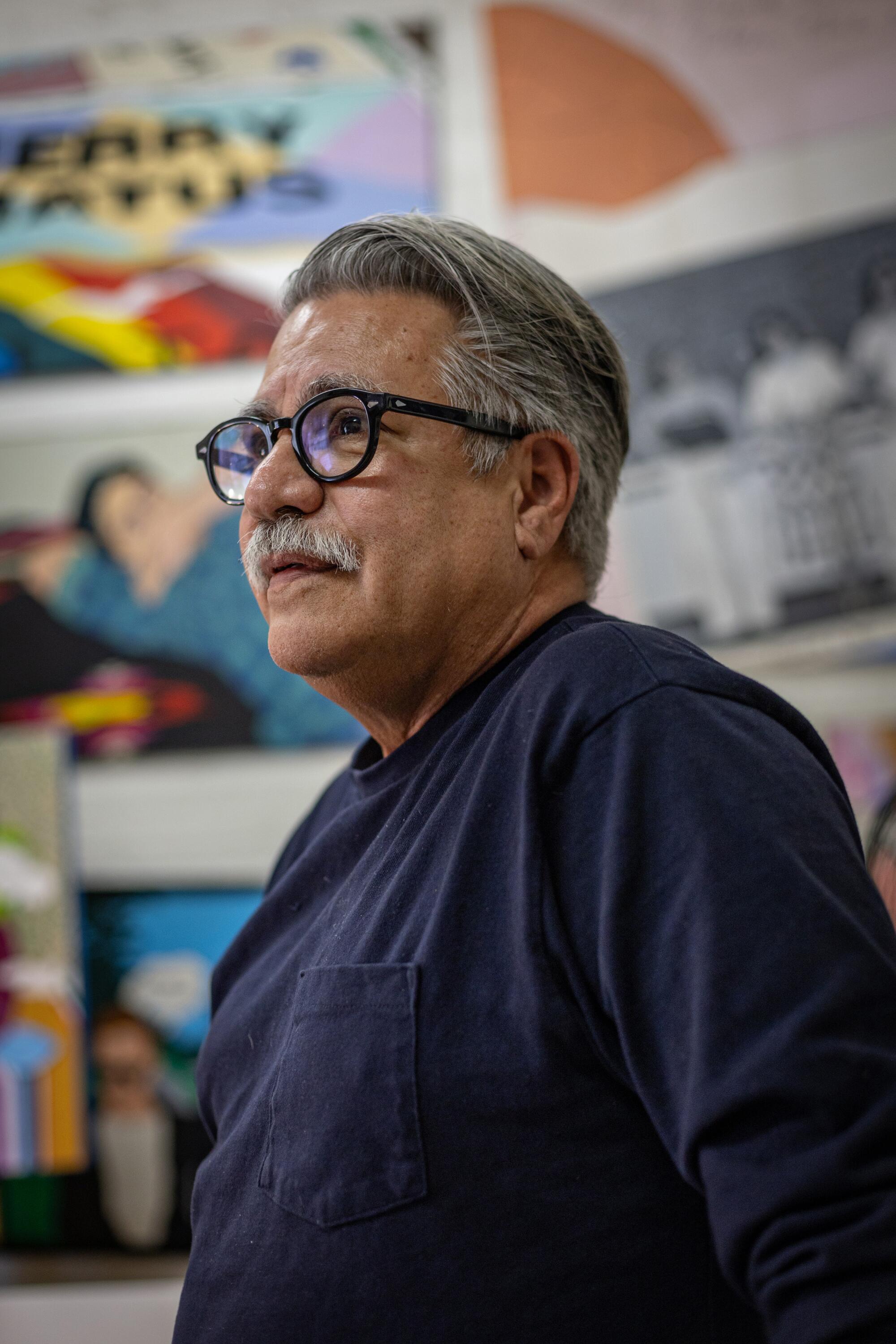
Terrill was born in Los Angeles in 1955 — “the year Disneyland opened and when rock ’n’ roll was born” — to parents of Mexican descent who hailed from Arizona and California.
From his earliest years, he remembers art being a part of family life. Terrill says his father was “a frustrated artist who worked in a factory,” whose abstractions could be found hanging around the house. In elementary school, when the young Terrill was assigned an art project about Mars in school, he created a little magazine that featured a drawing of the planet — as well as invented ads for the latest cosmetics for ladies on Mars. “The nuns were like, no,” Terrill says with a laugh. “I remember my dad saying, ‘You should get an A.’”
Lesser-seen works by Chicano artists illuminate. Plus, Robert Egan leaves the vaunted OPC, and the Getty repatriates works, in our weekly arts newsletter.
The Mars magazine was a prescient gesture, since Terrill began producing notable zines as a young artist in the ’70s. Some of these chronicled the vagaries of his life, others functioned as parodies. Particularly legendary is “Homeboy Beautiful” (a reimagining on “House Beautiful”), from 1978-79, which satirized masculinity and homophobia within Mexican culture, but also poked at the ways white society has historically viewed Mexicans.
The Selwyn exhibition pays homage to this history with a 56-page catalog fabricated as a zine.
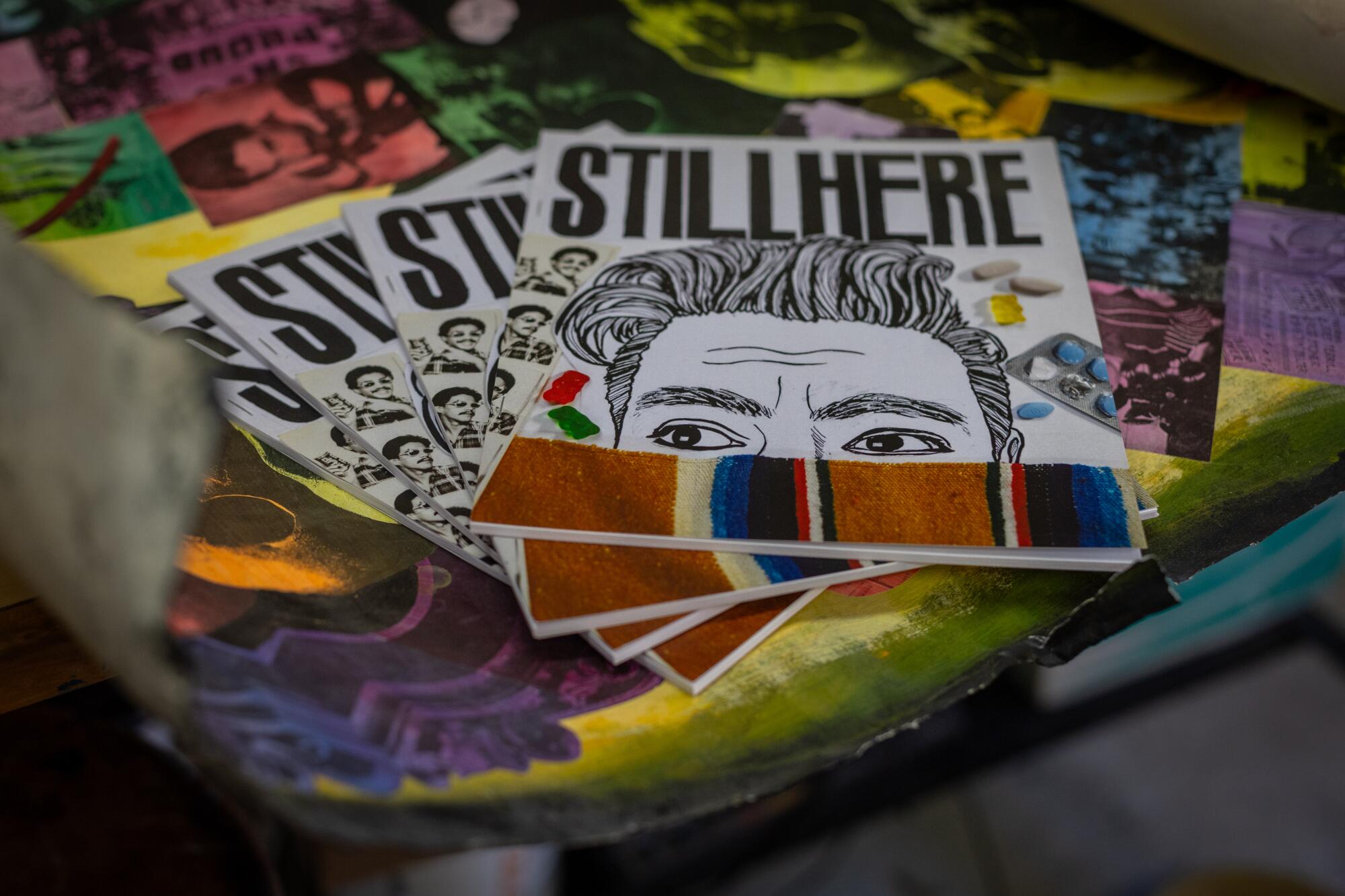
Ironically, a critical influence on his work ended up being another nun: Corita Kent, the artist and educator who taught at Immaculate Heart College in the ’60s and was renowned for her printmaking. “I remember seeing these images that were Pop Art, but — oh! — they were talking about God, light, spirit,” says Terrill. “I loved her work — the humor, the Virgin Mary as a tomato.” The latter is a reference to a now-iconic 1964 screenprint by Kent, titled, “the juiciest tomato of all,” that challenged typical figurative renderings of the Virgin by describing her in words drawn from a Del Monte tomato sauce slogan.
Inspired by Kent, Terrill attended Immaculate Heart, though she was no longer teaching there by the time he arrived in the early ’70s. Even so, the experience was formative. At the time, painting was allegedly dead (one of its all-too-regular deaths) and the focus was on the conceptual. Terrill, however, found inspiration in artists from the CalArts Feminist Art Program who taught at the school, including historian Ruth Iskin and painter Carole Caroompas (whom Terrill revered as an instructor). From them, he says, he internalized the feminist precept that “the personal is political.”
His experiences at Immaculate Heart — a deep formation in screenprinting and an attention to the intimate — laid a foundation for the work that was to come. By the ’80s, Terrill was producing paintings that featured solid blocks of color, echoing the nature of printmaking in graphically stylized ways. “He was thinking about how to create a visually complex composition with the least amount of color and an interesting use of line,” says Rafael Barrientos Martínez, the independent curator who helped organize the show at Selwyn.
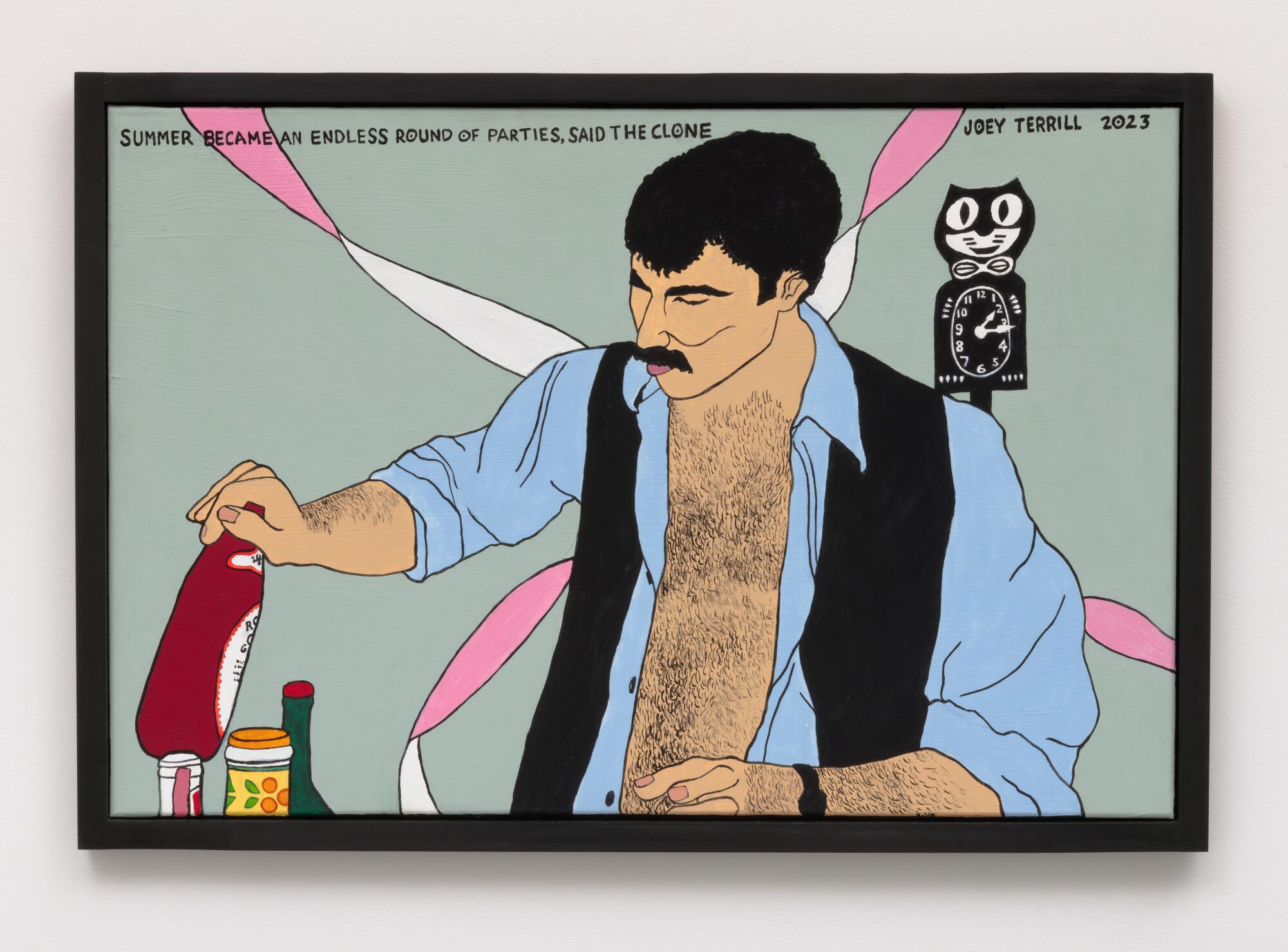
In this way, he chronicled his friends, his life, his trysts and his heartbreaks. In 1980, he lived in New York for 10 months, capturing his doings in the “Chicanos Invade New York Series” (now in MoMA’s collection). In these pieces, he is seen making tortillas in a Manhattan kitchen, standing before the Guggenheim Museum with his friends and reading about John Lennon‘s murder.
That journey marked a tipping point in his life.
Historic sites for women are rare, but Kent’s printmaking sat at the nexus of art, activism and politics. Her work and message couldn’t be more timely.
“I was four blocks away when Lennon was killed,” he recalls. “For me, it was a sign that, wow, the ’70s were over. Harvey Milk had been assassinated in ’78. Reagan had just taken office. I was like, the ’80s are going to be different. Six months later, the first reports of Kaposi’s sarcoma and AIDS begin to emerge.”
Even when confronted with his own diagnosis, Terrill never stopped making art. In fact, in the late ’80s and early ’90s, when AIDS was claiming lives with impunity, he created a series of ebullient paintings inspired by the attendees at his riotous Halloween parties. And, today, his studio bursts with in-progress still lifes, drawings of conceptual maps and a new portrait series inspired by colonial-era casta paintings.
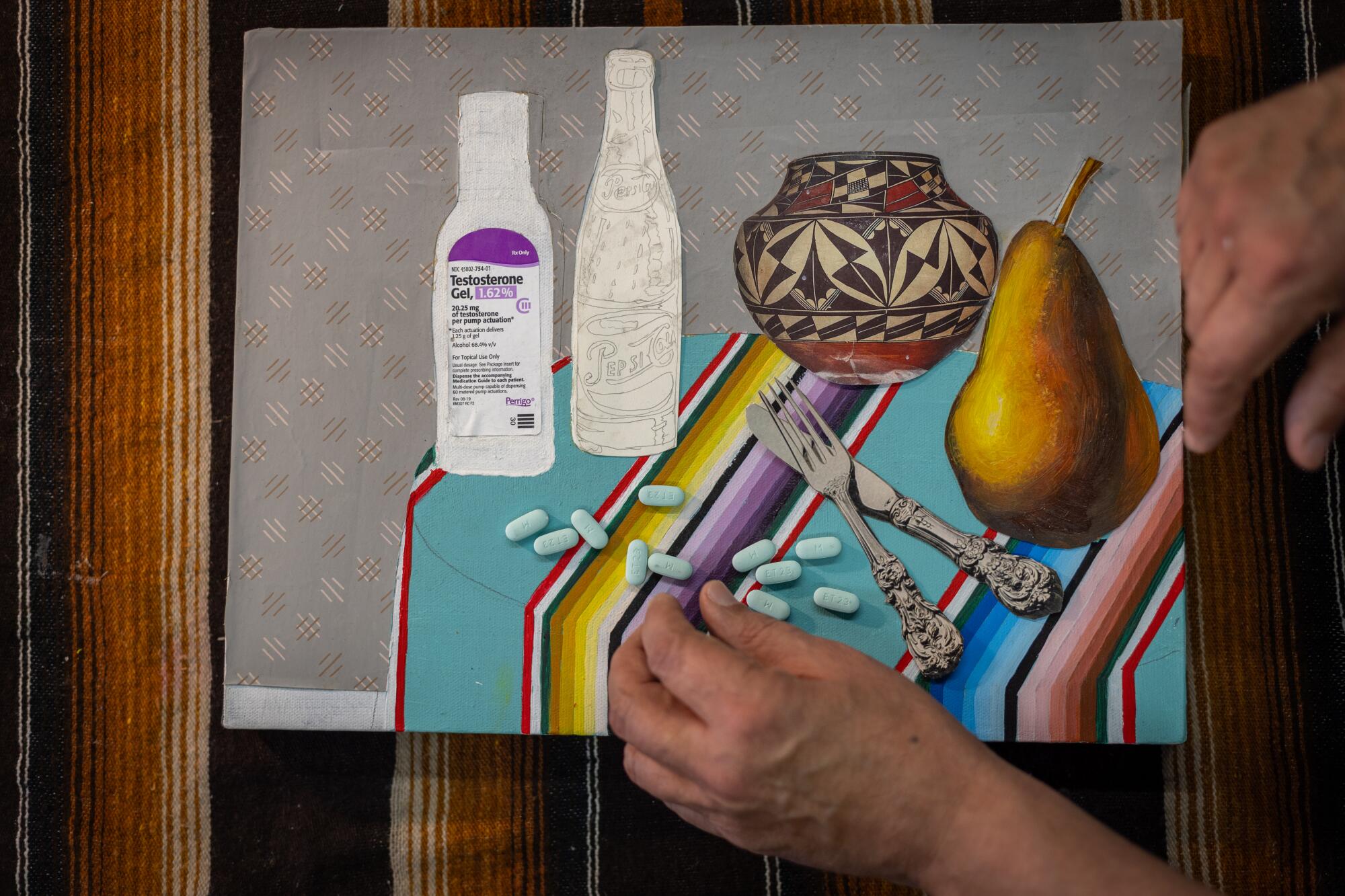
It was a 2017 show — part of the Getty-funded Pacific Standard Time series — that helped catapult Terrill into current public consciousness. Organized by curators David Evans Frantz and C. Ondine Chavoya, “Axis Mundo: Queer Networks in Chicano L.A.,” was a history-making exhibition presented at MOCA’s now-defunct Pacific Design Center space and the gallery of the ONE National Gay & Lesbian Archives. The show lovingly unearthed, documented and presented the work of a generation of queer Chicano artists, some of whom had been slipping into obscurity in the wake of untimely AIDS deaths.
Among those included were painter and conceptualist Gronk (born Glugio Nicandro), painter and collagist Teddy Sandoval and Terrill, who was represented by a number of works, including an early screenprint and issues of “Homeboy Beautiful.” (In a case of stars aligning, Sandoval, Terrill’s close friend and regular collaborator who died of AIDS-related complications in 1995, is currently the subject of a terrific Frantz-Chavoya-curated show at the Vincent Price Art Museum at East Los Angeles College.)
‘ONE Magazine at Seventy,’ an exhibit at the Los Angeles LGBT Center, lets visitors dig into the history of the first widely distributed gay publication in the U.S.
“‘Axis Mundo’ jump-started this whole new part of my art career,” says Terrill. He started receiving inquiries about his work. And, as the exhibition traveled to cities around the U.S., he also found himself invited to give talks, sit on panels and attend openings. The public appearances, in some ways, wove together the two main strands that run through his life: art and advocacy.
“I’m here and I can tell my story,” Terrill says he would tell assembled audiences. “But I’m also here to tell my friends’ stories, too — because I can.”
If once, he was filled with ambivalence, today he has none. Terrill is still here and he is bursting with the stories of life.
'Joey Terrill: Still Here'
Where: Marc Selwyn Fine Art, 9953 S. Santa Monica Blvd., Beverly Hills
When: Tuesday–Saturday, 11 a.m.–6 p.m. Through March 3.
Info: (310) 277-9953, marcselwynfineart.com
More to Read
The biggest entertainment stories
Get our big stories about Hollywood, film, television, music, arts, culture and more right in your inbox as soon as they publish.
You may occasionally receive promotional content from the Los Angeles Times.
